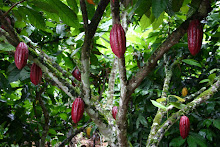Coffee
Coffee production came to Peru in the 1700s. After two centuries, the heirloom typica variety still comprises 60 percent of the country's exports. There are more than 110,000 coffee growers in Peru, most of whom are indigenous to these landscapes and speak Spanish as a second language. The average land-holding farmer lives on two or three hectares, hours away from the comforts of electricity and running water. Peru’s coffee exports account for two percent of both the national economy and the global coffee supply2, Peru is quickly building a global reputation for producing traditionally cultivated, shade grown, high quality Arabica beans.
Peruvian coffee farmers' landholdings are small, and the country's typical micro-wet-milling operation is even smaller. From May to September, farmers pick ripe cherries and carry them to hand pulpers and wooden fermentation tanks. This tradition of micro-wet-milling has protected Peru's water resources from the devastating effects of river-polluting pulping factories. After processing their coffee, most farmers hike their beans by foot or mule into the nearest town—a trip that can take anywhere from thirty minutes to eight hours. On Saturdays, the plaza of the closest town becomes a buying and selling station for the surrounding remote coffee growers. Farmers sell their coffee and buy goods for their homes before heading back up the mountainous foot trails.
An unfortunate--but all too common--experience at these buying and selling plazas is the arrival of only one buyer. This dramatically decreases the price paid to farmers for their coffee. With no personal warehouse space and only unreliable, expensive collective storage in town, farmers generally have no option but to accept lower prices. Buyers in the main city of the region then repeat this process during the week. The more remote the farms, the more times the coffees are mixed and traded before they arrive at the coast. Once there, the coffee is dry-milled and prepared for export. This unorganized trading system and isolation has caused farmers to become estranged from the end beverage that comes from their farms. For many years, growers have worked on a weight/dollar exchange for their coffee in the parchment, completely disconnecting the idea that they produce a beverage that will be enjoyed—or thrown away—based on its quality. Intermediary traders have even been known to increase the weight by throwing sand and water into each bag3.
Fair Trade cooperatives: cultivating alternatives with Peruvian coffee's futures
During the last decade, Peru’s smallholder cooperatives consolidated their movements and provided a more organized and rewarding opportunity for tens of thousands of smallholders who were once subjected to the exploitive trading practices explained above. An estimated 15 – 25 percent of Peru's 100,000+ smallholders now belong to cooperative organizations2. These cooperatives have linked with international Fair Trade and organic networks to stimulate their growth. Working together with partners like Equal Exchange, Peruvian smallholder cooperatives quickly became the second largest suppliers of Fair Trade certified coffee after Mexico and one of the world's top organic producers. The higher prices offered through these certified and specialty markets have strengthened cooperatives and offered at least some price premiums to farmers. The more direct market access has also helped four Fair Trade Certified co-ops establish themselves among Peru's largest 21 coffee exporters2.
Cooperatives have invested these price premiums and many donations from international development agencies into building infrastructure for improving coffee quality, processing and exporting, training farmers in their transition to certified organic production and social development projects.
The significant differences that farmers experience go well beyond better prices received at the farmgate. The differences are about being organized and developing a collective sense of identity through participation in their cooperatives, about the ability to own and control their means of production, and about the shared learning process through trainings and farmer exchanges. One farmer shares her reflections, "Before there were no trainings. But now they tell us about the roles of men and women. You learn to value yourself. You learn about participation
